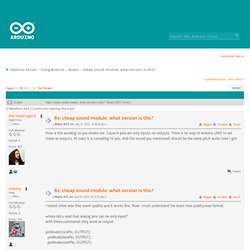

MSX2 Technical Handbook (PSG) Generalinstrument_ay-3-8910.pdf (objeto application/pdf) Cheap sound module: what version is this? I wouldn't give up rebel-agent, the module works, just check again all connections, pins, code used and i would change the soldered pin to 5volts i am not using any resistor what i understood of this board: 1. seems it doesnt play the 0000 named file (starts playing 0001)2. if i connect to analog pins of arduino it plays some sounds fine while other doesn't play correctly3. if i connect to digital pins of arduino it plays sounds fine4. it needs around 1 second of delay at startup.5. needs to add the exact lenght time of each track using "delay" command video test here: code used on the video test: /* SOMO-14D Test Control a SOMO-14D module to play sounds Reference Created 20 October 2009 By Shigeru Kobayashi */ const int clockPin = 6; // the pin number of the clock pinconst int dataPin = 9; // the pin number of the dataPin pinconst int resetPin = 3; // the pin number of the reset pin const unsigned int PLAY_PAUSE = 0xFFFE;const unsigned int STOP = 0xFFFF; sendCommand(VOLUME_7);} void loop() {

Arduino midi file player. The Midi Controller. Kalshagar - Arduino and a YMZ294. Volume is low, you can see me in reflection ... I know ... hope you like it anyway.See also how to generate tunes from MIDI files at MIDI, CSharp and Yamaha chips. Documentation Suggested wiring hint here under. The bold pins are the difference between the YMZ294 and the YMZ284. You can wire it otherwise, but if you wire like that my samples will work directly : Datasheets NONE on the net, not even on Yamaha website. Websites and tutorials Wikipedia : no datasheet but you've got an idea of what it does : like everything is in japanese... Things to know Beware of short-circuits : the oscillator I got had its case connected to the ground, and one Vcc wire too long was short-circuiting because touching it.You need 11 pins to drive it : 8 for data bus, 3 for control (WR, CS, A0)Port TEST should be left un-connectedPort IC (reset) can also be left unconnected (it seems at least) Code Shopping.
Texas Instruments SN76489. Origem: Wikipédia, a enciclopédia livre. Pinagem do CI Texas Instruments SN76489 padrão. O encapsulamento é no padrão DIP de 16 pinos. O SN76489 Digital Complex Sound Generator (DCSG) é um CI gerador de som programável TTL da Texas Instruments. Contém três geradores de ondas quadradas e um gerador de ruído branco, cada um dos quais capaz de produzir sons de várias freqüências em dezesseis níveis de volume.[1] Sua principal aplicação tem sido a geração de música e efeitos sonoros em consoles, arcades e computadores domésticos (tais como o BBC Micro e o IBM PCjr). WTV020-SD-16P - Help & solution tree. I spent a several days ( 12-15 hrs ++) trying to get a WTV020-SD-16P to work as a standalone sound player, just as a test for my project.

It did finally work as a standalone. If I can do it, so can you, from this test setup, the experience can be built on. I used a buck power supply ( cost less than $2 ) to get the 3.3 V from a 5v power supply ( the 5V power supply is a cell phone charger ). Some really good information is scattered in the forum, so I started a post here just for listing best practices and troubleshooting tips. My big problem: Wired very simply as shown, MP3 mode, when the play was triggered by connecting pin 9 to ground, all that came out was a feeble 1/2 sec beep. After reformatting the memory card, copied sample .ad4 files to the card & voila ! I also wired pin 2 [DAC +] up to a 15W amp to drive a car speaker. YM2612 - Documents - Maxim’s World of Stuff. Many years ago, there was a file called SEGA2.DOC which was a Mega Drive technical manual with a bunch of errors and some file corruption. A bit less long ago, a bunch of scans surfaced which seemed to exactly match, including a lot of hand-written parts corresponding to the more extreme errors; I transcribed and corrected the errors on this page.
More recently, some better scans of the same manual, but in better quality without all the errors and some slightly different wording, appeared. I’ve updated this page with those scans and their pagination. Pages are numbered and hyperlinked for your convenience. Shading indicates additions/corrections/comments. Contents Original page numbers Page 4 - original - top Overview The Yamaha 2612 Frequency Modulation (FM) sound synthesis IC resembles the Yamaha 2151 (used in Sega’s coin-op machines) and the chips used in Yamaha’s synthesizers.
Its capabilities include: There are two sets of three FM channels, named channels 1 to 3 and 4 to 6 respectively.